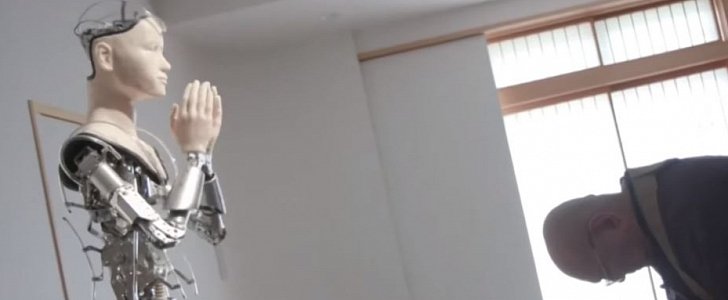In what is a sign of things to come, there is now a robot preaching sermons at a Japanese temple. Japan has always been two steps ahead the rest of the world in terms of incorporating technology in every aspect of their life, but this is a giant leap even for them.
For centuries, religion has been off-limits to technological developments, with the degree of resistance varying according to religion. The Buddists at the Kodaiji temple in Kyoto, however, believe that the benefits of technology are two-fold: it will help bring in young people who feel disconnected from religion and it will replace them when they’re gone.
Mindar is the brainchild of esteemed robotics professor Hiroshi Ishiguro and cost the equivalent of $1 million to make. For the time being, it’s not powered by AI, so it just delivers snippets that explain Buddhist teachings in plain terms. However, it will be so in the near future, in the hope that it will start acquiring information and wisdom to the point where it will be capable to speak directly to those in need, depending on their needs.
Mindar was modeled after Kannon Bodhisattva, the Buddhist deity of mercy, and is made entirely of aluminum, with silicone used for the face and hands. It stands 195 centimeters tall and weighs 60 kilograms, and will be able to move around.
The robot was first introduced to the media at the beginning of the year and is now at the 400-year-old monastery, preaching sermons. Reception has varied from outrage to optimism, and it’s only natural that people be reticent when it comes to introducing AI to religion, Adrienne Mayor, a research scholar in Classics and the History and Philosophy of Science and Technology Program at Stanford, tells ScreenShot.
“How can one trust that the machine learning and algorithms would always be beneficial to the users and not to the makers and deployers of robot priests?” Mayor says. “Could AI distinguish between immoral acts and moral values? Could AI discern motives and intentions and recognize sincere remorse, experience empathy, or truly embody the human qualities of mercy and forgiveness?”
The monks at the temple believe that Mindar is the key to the future – a future in which they won’t be alive anymore to guide and comfort those in need of spiritual assistance. But Mindar will live for ever.
Mindar is the brainchild of esteemed robotics professor Hiroshi Ishiguro and cost the equivalent of $1 million to make. For the time being, it’s not powered by AI, so it just delivers snippets that explain Buddhist teachings in plain terms. However, it will be so in the near future, in the hope that it will start acquiring information and wisdom to the point where it will be capable to speak directly to those in need, depending on their needs.
Mindar was modeled after Kannon Bodhisattva, the Buddhist deity of mercy, and is made entirely of aluminum, with silicone used for the face and hands. It stands 195 centimeters tall and weighs 60 kilograms, and will be able to move around.
The robot was first introduced to the media at the beginning of the year and is now at the 400-year-old monastery, preaching sermons. Reception has varied from outrage to optimism, and it’s only natural that people be reticent when it comes to introducing AI to religion, Adrienne Mayor, a research scholar in Classics and the History and Philosophy of Science and Technology Program at Stanford, tells ScreenShot.
“How can one trust that the machine learning and algorithms would always be beneficial to the users and not to the makers and deployers of robot priests?” Mayor says. “Could AI distinguish between immoral acts and moral values? Could AI discern motives and intentions and recognize sincere remorse, experience empathy, or truly embody the human qualities of mercy and forgiveness?”
The monks at the temple believe that Mindar is the key to the future – a future in which they won’t be alive anymore to guide and comfort those in need of spiritual assistance. But Mindar will live for ever.













